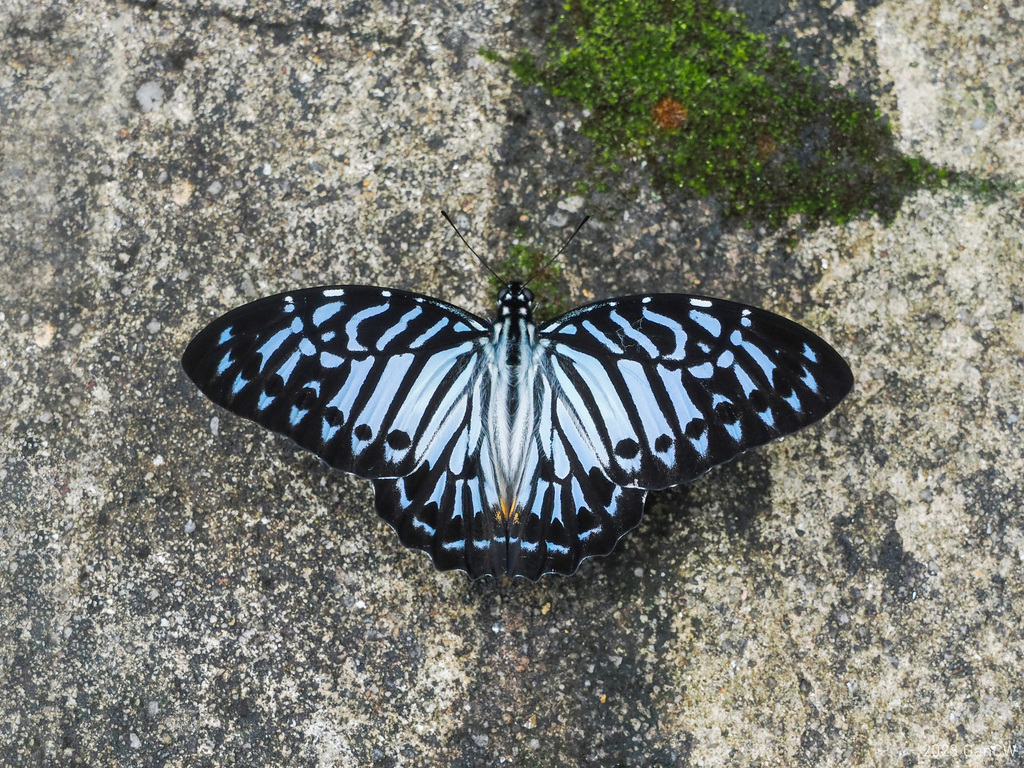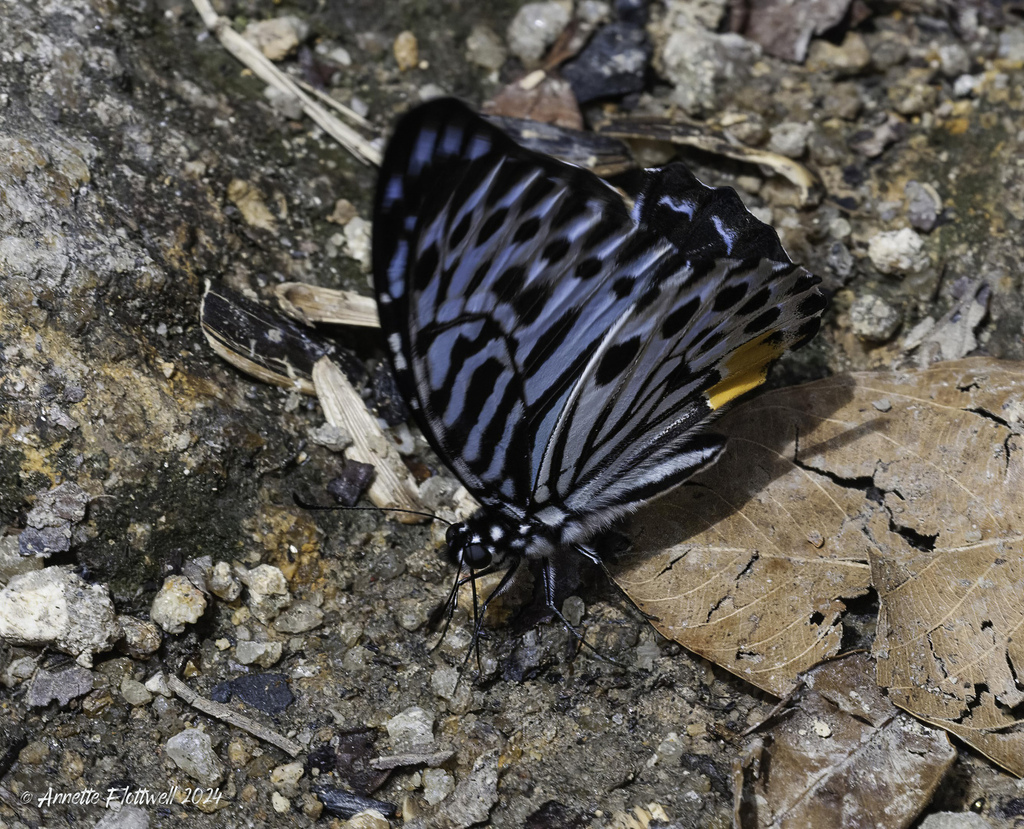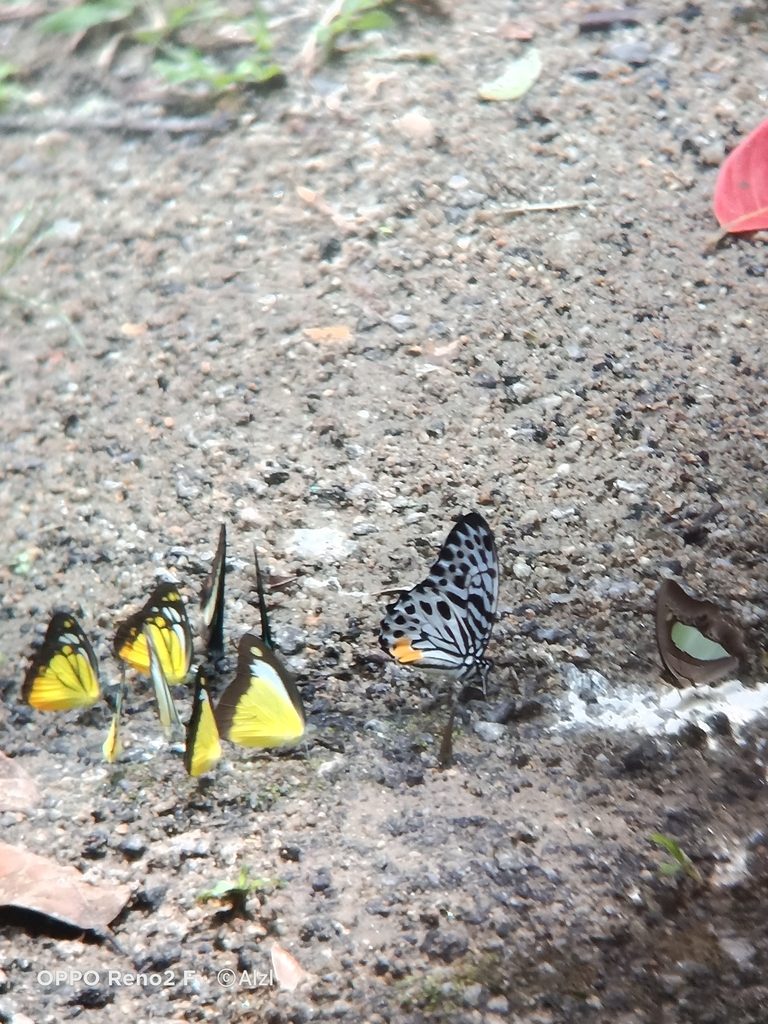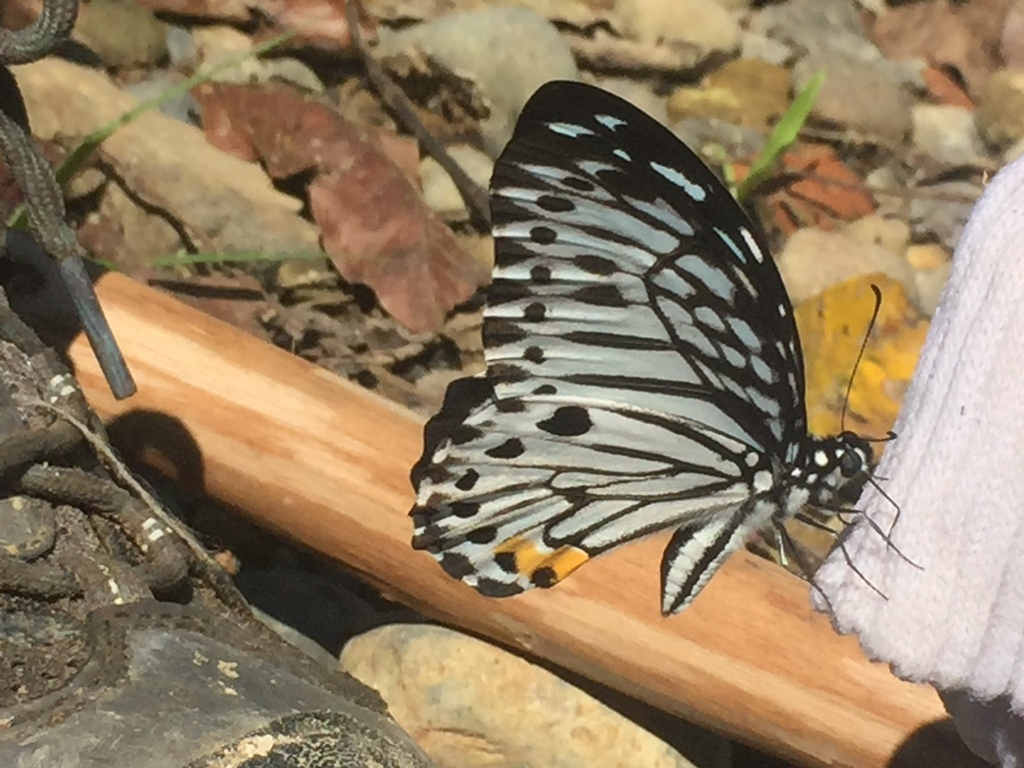Graphium delessertii, the Malayan Zebra, does have black and white (or dark drab and white) stripes. It has even more black and white spots. It does not have "swallow tails," but its wings have the general structure of a Swallowtail's, so it is classified in the Swallowtail family.
For a tropical Swallowtail it's not very big, with a wingspan usually over three but not so much as four inches. (Females, which are rarely found, are larger than males.) Still, it has the classic Swallowtail attitude. See it flying toward a camera at https://ronnieooist56.blogspot.com/2024/12/common-lowland-butterflies-in-november.html . If you check out the monthly photo essays at that blog, you'll see how many butterflies share the black-and-white spots-and-stripes coloring, in this habitat, and begin to wonder which is the most toxic to predators and which are merely getting the benefit of looking like the toxic one.
In flight, black and white wings blur into grey, and this species is often found in places where this effect offers some camouflage benefit against a background of grey stones. Males hang out at puddles, not obsessed with being the only one of their kind in a flock, but more often found in mixed flocks than with other delessertii.
Visitors from Singapore felt that their time and money were well spent when they visited this delessertii's habitat on Sabah island. They saw one delessertii join a mixed flock at a puddle. He was followed by a Birdwing and a Red Giant Flying Squirrel. And they got nice clear photos of lots of other pretty butterflies, as well.
Instinctive color-matching may be at work since these flocks often include other fairly large black and white butterflies and smaller yellow ones...the underside of male delessertii's wings show yellow patches.
Photo by Annetteflottwell, showing that at some angles the white color can iridesce blue. (You might need to tilt your screen to see it.)
hoto by Sl_Liew.
Photo by Floatingkittem. Are the yellow butterflies getting some protective benefit from looking like delessertii's spots?
Photo by Wbleisch. This one shows a positive interest in a sweaty sock. They also pollinate several kinds of flowers, usually small flowers because they have large heads and short tongues, but in many Swallowtail species males have to ingest some quantity of mineral salts in order to reproduce.
Males of this species seem not to be overly bold toward humans, but they are easily found at puddles. Females are more elusive and in collections, even photo collections, they can be considered rare. They may resemble males without yellow spots, or have a different black-and-white pattern and look more like another of their look-alike species, Ideopsis gaura, which is not even a Swallowtail. In this pattern the black markings are finer overall and more noticeable toward the edges.
These look-alike species are sometimes called the rice paper butterflies. They remind me more of Victorian fashion plates, in which society belles who dressed in fashionable respect to other people's mourning would always choose black and white over, e.g., blue and white, but oh, the profusion of black and white frills and flounces! (This would of course have been late Victorian fashions, with bustles rather than hoops. Only in the late Victorian era did black and white become the correct thing to wear to indicate that you were not actively in mourning for a member of your own family, but merely fitting into the generally funereal mood along with those who were. Early Victorians thought the combination of black and white, if not relieved by a bright color somewhere, looked "ghastly.")
Though humans rarely get close enough to be sure they've seen a female of this species, there are enough females to go around. The species as a whole seems not to be endangered. The population on Java island has been threatened by logging and displacement. There seem to be several generations in a year--the photographs above show date stamps in September, December, and April.
Three subspecies have been identified. Graphium delessertii delessertii, which is found on the Malay peninsula and nearby islands, is distinguishable from G.d. palawanus, which is found in the Philippines, and G.d. hyalinus, which is found only on Nias island. Museum specimens of subspecies delessertii and palawanus are in the gallery of images at
They look very similar. Nevertheless, this species has had quite a few names. It was recognized early enough to have been registered as Papilio delessertii and also placed in a proposed new genus as Paranticopsis delessertii. The genus name Arisbe has been more recently applied to its group of Graphium. Species names catoris, labienus, sacerdotalis, melanides, and laodocus were proposed by people who didn't recognize delessertii as a species that had already been discovered, or thought a superficial variation in markings might be consistent enough to qualify as a species difference. The name catoris, commemorating a person who caught one, may have been given to a female since its wingspan was reported to be four and a half inches. A species name albinistica may have mistaken a thin-lined, white-looking female for a different species.
One other proposed species name, dehaani, commemorates a scientist and was popular enough that it's still found on some species lists today, although the butterflies identified as dehaani are now thought to have been ordinary delessertii. De Haan was correct in identifying Graphium dorcus as a distinct species. He was incorrect in thinking two variations in the markings of delessertii from Borneo represented two more species, which he named melanides and laodocus, but then other scientists argued that although those two variations belonged in one species, that was a different species from delessertii. Scientists now say they're all the same animal.
Merely identifying a Graphium in Malaysia is admittedly a challenge...
The species was first described, in French, by a naturalist called Adolphe Delessert. He had to describe it so accurately that a person who'd never seen it could recognize it, without any pictures. He deserves no extra points for doing the description in French since that seems to have been his native language, but I think he does deserve to have its name commemorate his feat.
The cuteness rating of all the rice paper butterflies is high. They've been portrayed on postage; individual severed wings, or photos thereof, have been laminated for use as earrings; they've inspired the usual arts-and-crafts tributes. They have not, however, had their life history documented. Nobody seems to know for sure what they eat or what the early stages look like. The Javanese know that in their forests there are some trees that can be sold for money, which the Javanese want, and unfortunately, whether it's because trees or vines are removed or for whatever other reason, when they cut down and sell their trees they seem to be losing some butterflies, which, though very cute, are not good for a lot of money. Clearly it would be useful to know what the butterflies eat and what are the essentials for their life, just in case there might be a way to harvest a few trees without destroying this species. But nobody seems to be sure...
[Temporary paragraph, to be removed when it's served its purpose.]
...Except a nasty web site called picture-insect.com, which has clearly made it into Google's top hundred search results by paying money to Google. According to picture-insect.com, delessertii "harms plants" because caterpillars eat leaves. The site has no specific information about these butterflies or their caterpillars. Its claim that they eat Aristolochia leaves is probably based on the generalization that a lot of Swallowtail caterpillars eat Aristolochia leaves; if there is a better base than that, the world ought to know. There is a good chance that delessertii do eat Aristolochia leaves--and, if they do, they are completely harmless, because no monophagous caterpillar destroys its host. Aristolochia grow as fast as their symbionts (caterpillars and other creatures that eat their leaves) eat them. Caterpillars that "harm plants," in the sense of making unsightly messes in gardens or affecting crop yields, are well documented; Graphium delessertii clearly is not a garden nuisance, as some Annonaceae-eating Graphiums can be. On no evidence, probably merely by letting "artificial intelligence" generate pages for their site, the producers of picture-insect.com are leading people to believe that a harmless little animal whose economic effect, if any, is favorable (it's a pollinator) is a harmful animal that ought to be killed. The site is so poorly produced overall that I'm more inclined to blame "AI" than a malevolent campaign to reduce sympathy for Graphium delessertii in Java...but, considering all the web sites that Google refuses to show at all, these days, I think picture-insect.com is a prime example of a site Google should refuse to show. An honest, uncensored search engine could simply push picture-insect.com's ranking down to number 58,000 out of 65,000 and bask in the knowledge that it wouldn't be found twice in a hundred years. Google, having become what it now is, should recognize a cheat when it finds one and suppress picture-insect.com from all search results unless, and until, it's required by law to display all search results. Readers' complaints may help with this.






No comments:
Post a Comment